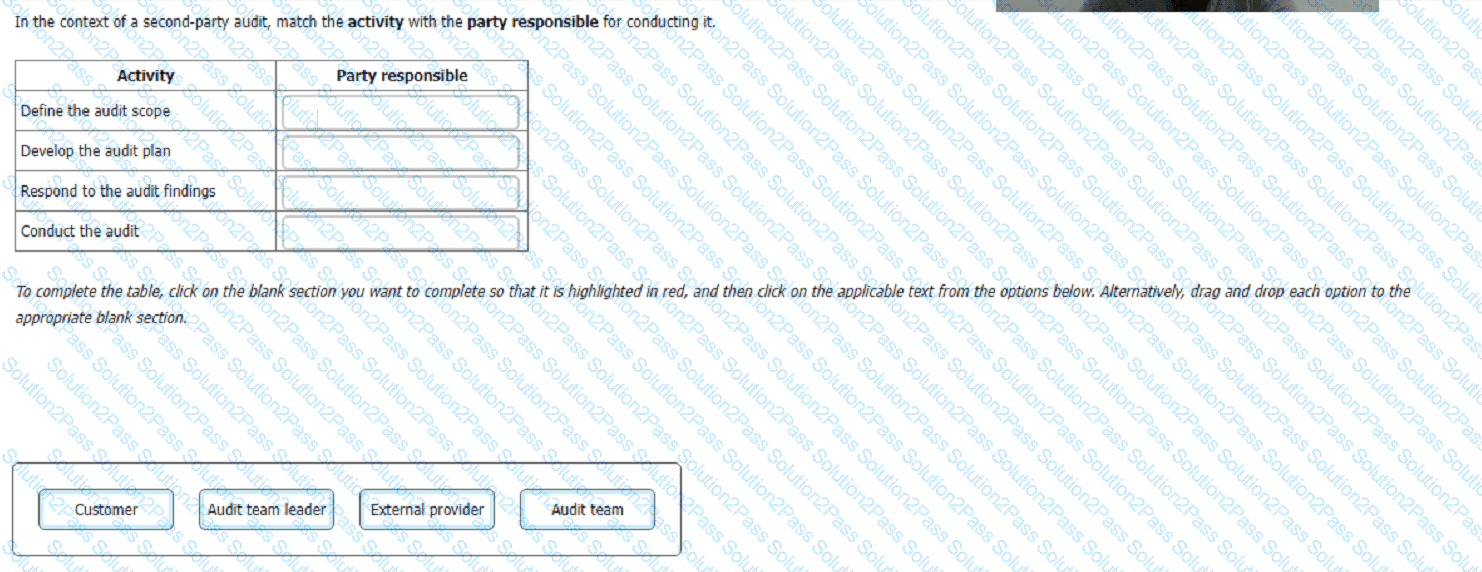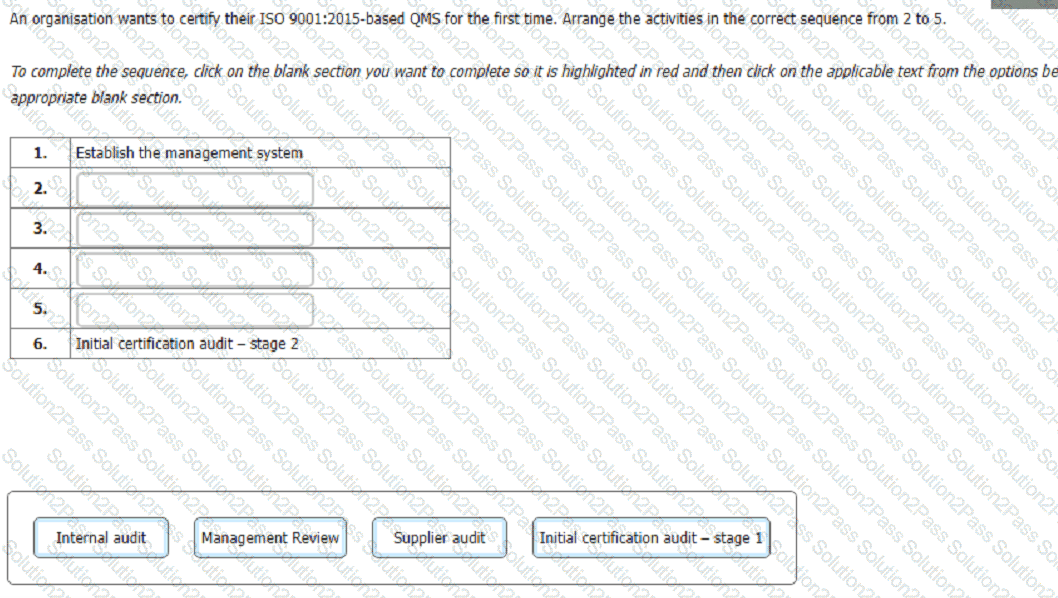ISO-9001-Lead-Auditor PECB QMS ISO 9001:2015 Lead Auditor Exam Free Practice Exam Questions (2025 Updated)
Prepare effectively for your PECB ISO-9001-Lead-Auditor QMS ISO 9001:2015 Lead Auditor Exam certification with our extensive collection of free, high-quality practice questions. Each question is designed to mirror the actual exam format and objectives, complete with comprehensive answers and detailed explanations. Our materials are regularly updated for 2025, ensuring you have the most current resources to build confidence and succeed on your first attempt.
In the context of a third-party audit, select the issue which is not expected to be included in the audit plan.
Scenario 2:
Bell is a Canadian food manufacturing company that operates globally. Their main products include nuts, dried fruits, and confections. Bell has always prioritized product quality and has maintained a good reputation for many years. However, the company's production error rate increased significantly, leading to more customer complaints.
To increase efficiency and customer satisfaction, Bell implemented a Quality Management System (QMS) based on ISO 9001. The top management established a QMS implementation team comprising five middle managers from various departments, including Leslie, the quality manager.
Leslie was responsible for assigning responsibilities and authorities for QMS-related roles. He also suggested including a top management representative in the QMS team, but top management declined due to other priorities.
The team defined the QMS scope as:
"The scope of the QMS includes all activities related to food processing."
Leslie established a quality policy and presented it to the team for review before top management approval. Top management also proposed a new strategy for handling customer complaints, requiring biweekly customer surveys to monitor customer perceptions.
In scenario 2, the team determined the QMS scope by taking into account only the requirements of top management. Is this compliant with ISO 9001?
Which two of the following auditors would not participate in a first-party audit?
Match the following potential audit client options to the type of audit.

Which two of the following aspects of a quality management system must the organisation continually improve?
In the context of a third-party management system certification audit, which two of the following statements are correct?
You, as auditor, are in dialogue with the quality lead and managing director of a small business that supplies specialist laboratory equipment and furniture.
You: "I'd like to look at how you manage change in the organisation. What changes have you made as a
business, say, over the last 12 months?"
Auditee: "We have made some strategic changes, the main one being that we no longer manufacture our
own products in house."
You: "That sounds like quite a significant change. What has been the impact of that?"
Auditee: "We now mainly sell other manufacturers' products, under their brand names, and have outsourced
manufacture of our own brand products to one of our suppliers. Unfortunately, we had to make six members
of our staff redundant. This represents about 20% of our workforce, so this has been quite a challenging
time."
You: "I'm sure. What were the reasons for making the change?"
Auditee: "Our manufacturing section was a small operation, and we struggled to cope with fluctuations in
demand. During busy periods, we found it hard to meet lead times, and in quiet periods we had staff with
little to do. This was having an impact on customer satisfaction and meant we had to charge premium prices
that made our product uncompetitive."
You: "How did you go about the change?"
The auditor asks to speak to the purchasing manager about the selection of the subcontractor to
manufacture the company's own brand products.
You: "How did you choose a supplier to manufacture your products?"
Auditee: "We have had a long-term relationship with a supplier ABC Ltd - we gave them our design
drawings, got them to complete a supplier questionnaire and run a couple of trial batches for us. We were
happy with the result and we have used them ever since."
ISO 9001:2015, clause 8.4.1 outlines situations when controls need to be applied to externally provided processes, products and services. Which one of the following situations is applicable to this scenario?
In the context of a second-party audit, match the activity with the party responsible for conducting it.
Which of the following three options could be considered potential threats to impartiality in an audit context?
What does the application of the process approach in a QMS enable?
An audit team of three people is conducting a Stage 2 audit to ISO 9001 of an engineering organisation that manufactures sacrificial anodes for the oll and gas industry in marine environments. These are aluminium products designed to prevent corrosion of submerged
steel structures. You, as one of the auditors, find that the organisation has shipped anodes for Project DK in the Gulf of Mexico before the galvanic efficiency test results for the anodes have been fully analysed and reported as required by the customer. The Quality
Manager explains that the Managing Director authorised release of the anodes to avoid late delivery as penalties would be imposed. The customer was not informed since the tests very rarely fall below the required efficiency. You raise a nonconformity against clause 8.6 of ISO 9001.
Which of the following options for the best description of the nonconformity?
Which two of the following work documents are not required for audit planning by an auditor conducting a certification audit?
Select one of the options that best describes the purpose of conducting a document review:
An organisation wants to certify their ISO 9001:2015-based QMS for the first time. Arrange the activities in the correct sequence from 2 to 5.
To complete the sequence, click on the blank section you want to complete so it is highlighted in red and then click on the applicable text from the options below. Alternatively, drag and drop the
options to the appropriate blank section.

Below are four of the seven principles on which ISO 9000 series are based. Match a potential benefit to each of the quality management principles (QMP).

One of the conflict resolution techniques is toning down. How is the conflict managed in that case?
TIX provides services to the informatic equipment of large organisations. They operate an ISO 9001:2015 QMS that is being audited by an important
customer (second-party audit). During the audit, the audit team has identified two nonconformities. When preparing the Closing meeting, the audit
team discussed and agreed both nonconformities with TIX's quality manager. The Closing meeting was planned for 6pm with the general manager,
quality manager and service manager at the meeting room.
At 6pm, when the audit team enters the meeting room, only two people are present and waiting for them: the Health and Safety supervisor and the
warehouse supervisor. Neither have participated in the audit.
The dialogue among them is as follows:
Audit team leader: "Good evening, could you please inform the three managers that we are ready to start with the Closing meeting?"
Health and Safety supervisor: "Good evening. We are sorry to inform you that the general manager was involved in a serious car accident, and
the other two managers have had to leave urgently to attend the emergency."
Warehouse supervisor: "They have asked us to listen to what you need to say and to sign whatever we need to sign. We also have a message
from them about the two nonconformities. They wanted us to ask you if you could contact them in a couple of days to determine how to proceed."
Which one of the following options would be your preferred response to the final comment made by the warehouse manager?
What is a list of actions that should be performed during the audit with their respective timeline?
Scenario 7: POLKA is a car manufacturing company based in Stockholm, Sweden. The company has around 14,000 employees working in different sectors which help with the design, painting, assembling, and test drives of the final product. The company is widely known for its qualitative products and affordable prices. In order to retain their reputation, POLKA implemented a quality management system (QMS) based on ISO 9001.
Before applying for certification, the company decided to conduct an internal audit to check whether there are any nonconformities in their QMS and if the requirements of ISO 9001 are being fulfilled. The top management appointed Sean, the internal auditor, as the team leader of the internal audit team. Sean required from the top management to have unrestricted access to the employees and executives of POLKA and to the documented information. Furthermore, Sean required to establish a team with a large number of auditors, considering the size and the complexity of the organization. The top management of POLKA agreed with Sean's requirements.
The top management, in cooperation with Sean, assigned 10 more employees to the audit team. Following that. Sean planned the audit activities and assigned the roles and responsibilities to each auditor. They began by interviewing employees of different manufacturing departments to check whether they are aware of the process of the QMS implementation. While conducting these activities, one of the auditors asked Sean for permission to audit the department in which he worked on a daily basis, as he was very familiar with the processes of the department.
Along the way, the teams findings showed that the staff were trained, documented information was updated, and the QMS fulfilled the requirements of ISO 9001. The internal audit took three weeks to complete, and on the last week the audit team held a final meeting
The team shared their results and together drafted the audit report This report was submitted to the top management of the company. The report was maintained as documented information, and was available to the relevant interested parties.
Based on the scenario above, answer the following question:
Based on Scenario 7, the team worked together to draft the final audit report. Is this acceptable?
What is reliability in the context of service quality?




 A screenshot of a chat Description automatically generated
A screenshot of a chat Description automatically generated